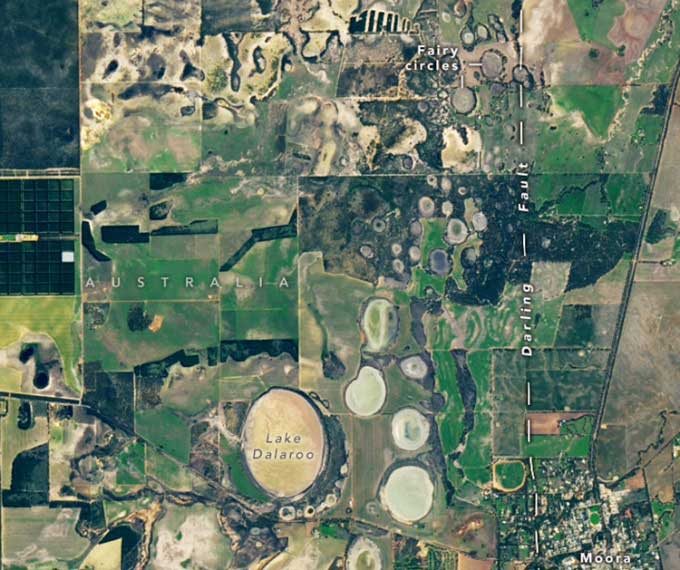NASA satellite captures numerous circular structures near the town of Moora, where hydrogen concentrations in the surrounding soil are particularly high.
The pockmarked landscape in Australia may serve as a treasure map for a source of clean, natural energy, SciTechDaily reported on September 7. Experts have discovered clusters of “fairy circles” in the North Perth Basin of Western Australia that are leaking hydrogen gas. Such natural hydrogen sources have been found across multiple continents and are gaining increasing attention as the world seeks alternatives to fossil fuels.

Landsat 9 satellite captures images of fairy circles near the town of Moora, Australia. (Photo: NASA Earth Observatory).
The NASA Earth Observatory announced on September 5 that it had released images of clusters of fairy circles near the town of Moora, located about 150 kilometers north of Perth. The images were taken by the Landsat 9 satellite on June 27. Here, the circular depressions are scattered along the Darling Fault in a north-south direction. The structures in the images have diameters of several hundred meters and are sometimes referred to as saline lakes. The vegetation and water levels in these lakes vary over time.
In 2021, scientists conducted gas-soil measurements inside and around several of the circular depressions. They found that the soil in that area contains hydrogen, with particularly high hydrogen concentrations in the soil surrounding the edges of the circles. This research, led by expert Emanuelle Frery from the Commonwealth Scientific and Industrial Research Organisation (CSIRO), confirmed the presence of natural hydrogen leaks in Australia for the first time and linked them to the geological characteristics of the area. However, according to Frery, the relationship between hydrogen, the circular structures, and vegetation types remains poorly understood.
Hydrogen can form beneath the Earth’s surface through various natural processes, including water-rock reactions and the molecular decomposition of water due to radiation. The North Perth Basin has several conditions that favor hydrogen production. The research team hypothesized that hydrogen forms when water reacts with iron-rich rock formations in the region. After reviewing geophysical data, they suggested that the fault lines could create vertical pathways for hydrogen to migrate to the surface.
Previously, many hydrogen sources were discovered by chance. For example, in the late 1980s, a group of well drillers in Mali found a reservoir of natural hydrogen with high concentrations. Now, satellite imagery easily reveals the fairy circles, which are potential hydrogen sources. Other semicircular and circular structures with high hydrogen concentrations have also been recorded in various locations worldwide, from Brazil and Russia to the United States. Experts believe that there are still many natural hydrogen sources yet to be discovered, which could be found with the right tools.
Human interest in hydrogen as a zero-emission fuel is growing. Currently, commercial hydrogen is produced through energy-intensive processes, such as splitting water into hydrogen and oxygen using electricity, or extracting hydrogen from fossil fuels. Some experts argue that natural hydrogen sources could be a viable alternative. However, many uncertainties remain about how and where hydrogen forms beneath the Earth’s surface, as well as the best methods for extracting and storing hydrogen.


















































